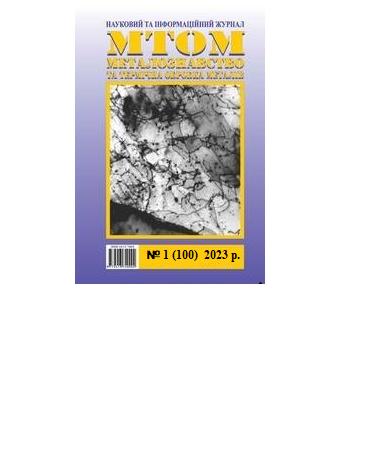FEATURES OF THE DEVELOPMENT OF SLIPPING ALONG THE BOUNDARIES HETEROPHASE INCLUSION “HIGH-MELTING PHASE SURROUNDED BY A LOW-MELTING SHELL” − STEEL MATRIX
DOI:
https://doi.org/10.30838/J.PMHTM.2413.280323.14.940Keywords:
steel, heterophase non-metallic inclusions, slipping, phases, interphase boundariesAbstract
Purpose. To study features of slippage at the interphase boundaries, heterophase inclusion “refractory phase surrounded by a low-melting shell” − steel matrix in the temperature range of hot deformation. Methods. Samples of steels were subjected to stretching at temperatures of 20...1 200 °C in a vacuum on the IMASh-5S device with special grippers, the speed of which was 20 mm/min. Research methods were used: petrography, micro-X-ray spectral analysis (“Cameca MS-46, Nanolab-7”, optical microscopy (Neophot-21). Results. It was found that the diversity of phases composing the heterophase inclusions of the “high-melting phase surrounded by a low-melting shell” type leads to their different behavior under plastic deformation. It was shown that during the high-temperature deformation the inclusion − matrix interphase boundaries, which are the boundaries between the inclusion-shell phase and the steel matrix, exhibit plasticity as a result of slipping. It was found that depending on the plasticity level of the phases composing the inclusion, the slipping occurs with different intensity. The features of the slipping process for heterophase inclusions of the “high-melting phase surrounded by a light-melting shell” type were analyzedScientific novelty. It is discussed the slipping mechanism for inclusions of the “high-melting phase surrounded by a low-melting shell” type containing phases with different plasticity levels, which is associated with the movement of interface dislocations at the inclusion − matrix boundaries (intrinsic slipping) or inserted dislocations as well as with contact friction and internal friction occurring at the boundaries due to the dislocation movement. It is shown that the activation of the slipping can occur due to the rearrangements of defects located at the interphase boundaries of the inclusion − matrix of steel. It was established that the difference in the nature of the phases-shells, as well as the influence of the second phase of inclusions “high-melting phase surrounded by a low-melting shell” contribute to difference in plasticity of inclusion-matrix boundaries of steel under high-temperature deformation. Practical value. The use of the obtained results will make it possible to develop technologies for producing steels with regulated types of heterophase non-metallic inclusions, which will significantly increase their technological and operational characteristics, as well as prevent the formation of various defects during the processing of steels by pressure and the operation of products.
Downloads
Published
Issue
Section
License
Authors that are published in this journal agree to follow the conditions:
Authors reserve the right to the authorship of his work and cede the right to the journal of first publication of this work on conditions of the license under the Creative Commons Attribution License, which allows others to distribute it freely with the obligatory reference to the author of the original work and the first publication of the work in this journal.

